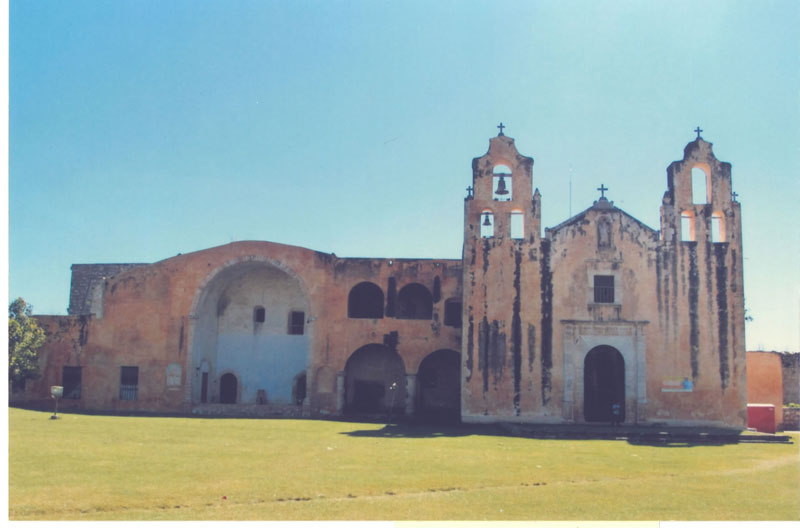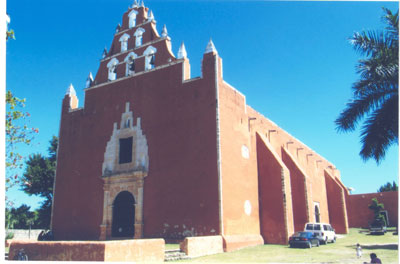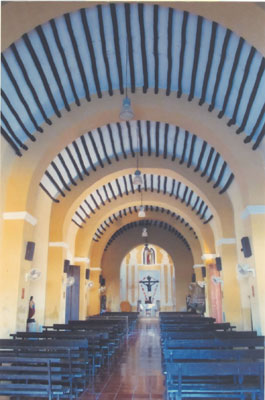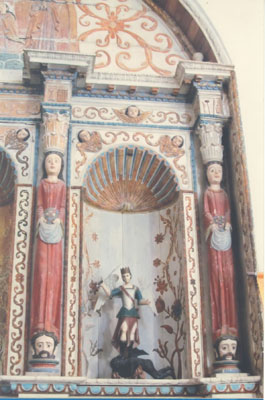Colonial missions in Mexico’s Yucatán
This item appears on page 60 of the October 2014 issue.
Spanish conquistadores, led by Francisco de Córdoba and, two years later, by Hernán Cortés, arrived in Mexico’s Yucatán in 1517. Following them came Catholic Spanish missionaries, particularly Franciscan friars, who made it their mission to convert the natives to Christianity.
Not long after their arrival, these Franciscans began to build missions, monastic complexes that included not only housing for themselves but churches for the newly converted.
The religious complexes the Franciscans built in the Yucatán in the 16th and 17th centuries are unique. My husband, Paul, and I wanted to visit a sampling of them and discovered that if we made a loop south of Mérida, where we were escaping New York’s nasty winter from mid-January to mid-February 2014, we could see many of the colonial monasteries.
Unique features
What made the Franciscan monasteries of the Yucatán unique? Most of those we visited were built on top of stone bases that once held Mayan pyramids or other Mayan structures. In fact, stones from the preexisting Mayan structures were often incorporated into the new Christian monasteries.
The churches the Franciscans erected were massive and fortress-like, often supported by equally massive flying buttresses. The façades were spare, occasionally relieved by carvings or statues. There were few windows to admit light, other than a choir window high above the west door.
But what is most distinctive about many of the Yucatán’s colonial churches is the espadaña, a gable on the west façade that served as an elegant belfry instead of the more usual bell tower found in churches in other parts of Mexico.
Yucatán colonial church interiors are as scaled down and spartan as the façades, sometimes embellished by splendid retablos, or altarpieces, lining either side of the nave of the church or serving as the main altar. Many of the churches have log ceilings.
First of the fortress churches
Our introduction to the Yucatán’s colonial churches was San Juan Bautista in Abala, 32 miles south of Mérida.
This church has most of the characteristics mentioned, including a fortress-like appearance with buttresses and few windows, but it differs in having two graceful bell towers instead of an espadaña gable. The inside is simple, with a beautiful semicircular, log-vaulted ceiling.
In the Asunción Church in Muna, 14 miles south of Abala, we saw our first espadañas, twin towering gables above the church’s facade. These espadañas help to lighten the massive, buttressed church exterior.
Inside, over the main altar, is a delicate statue of the Virgin Mary wearing a beautifully embroidered huipil, the traditional dress of Yucatecan women.
Twelve miles east of Muna, at Sacalum, is San Antonio de Padua, perhaps the most fortress-like of the colonial churches we visited, with an extremely severe façade, squat bell towers, age-darkened stonework and a turret.
Inside is the same type of log ceiling seen at Abala as well as several magnificent stone side altars bearing remnants of murals.
Church exteriors only
We were not lucky with our next two churches in Ticul and in Santa Elena. Although we had made an early start from Mérida, leaving at 7:30 a.m., both churches had closed by the time we arrived midday.
San Antonio de Padua in Ticul, nine miles southeast of Sacalum, has a beautiful exterior and so was well worth seeing even without going inside, where, we were told, there is a notable Black Christ altarpiece.
The church’s exterior is distinguished by an elegant, classical-style west doorway with paired columns with statues in niches, all surmounted by a choir window, scrolled gable and two espadañas.
The church of San Mateo at Santa Elena, 10 miles southwest of Ticul, is a sturdy-looking, ochre-colored edifice sitting atop a mound that was once the base of a Mayan pyramid or temple.
We didn’t get to see the church’s treasure, several box retablos that are portable altars housing crosses or saints’ images, but the adjacent church museum was open, with a small display of Mayan stone head replicas whose originals were found in the archaeological sites dotting the surrounding area.
Evening service
The last stop on our first day was San Francisco de Asís in Oxkutzcab, 19 miles east of Santa Elena, where we arrived just in time for the early evening service. We had just enough time to admire the church’s elegant façade, decorated with a classical west doorway, reliefs, crosses, statues and two espadañas, all highlighted by the last rays of the setting sun, before we were escorted inside to front-row seats in front of the main altar.
This was serendipitous because from this vantage point we had the treasure of Oxkutzcab right in front of us: the gilded retablo with four tiers of panels. Set between twisting baroque-style columns, the reliefs in the panels are in a charming naïve style.
Queen of churches
We began the next day with what I consider the queen of all the colonial churches we visited, San Miguel Arcángel in Maní, eight miles north of Oxkutzcab. This church was the scene, in 1562, of Bishop Diego de Landa’s infamous auto-da-fé in which invaluable and irreplaceable Mayan codices and images were burned en masse.
Maní has it all: the fortress-like exterior relieved by two elegant espadañas and by a unique open chapel to the left of the west doorway. There are extensive monastic buildings left — cloister, refectory, kitchen and dormitory — to give visitors an idea of what a 16th-century Franciscan monastery looked like. There’s even a unique old noria, or waterwheel, in the garden.
Inside the church are several magnificent 17th-century gilt retablos with elongated wooden maidens framing the sections and a main altarpiece beyond which were found 16th-century murals.
Unique murals
San Pedro y San Pablo is located in Teabo, eight miles east of Maní. This church has two lovely espadañas on its west façade and, inside, one of the most magnificent of all the colonial church retablos, featuring an Archangel Michael vanquishing a demon enshrined between two maidens who stand on bearded heads, similar to those at Maní.
What is most special here is found in the sacristy, where 400-year-old murals adorn the walls of two rooms. Although they portray saints and evangelists (you can see Mark and Luke with their symbols, the lion and the ox, respectively), these murals remind me of those at Pompeii in their coloring and delicacy.
From Teabo, it’s nine miles northwest to Mamá and the Asunción Church, with primitive stone reliefs surrounding its west door and my favorite espadaña of all those seen. It’s a majestic, 3-tier gable with three bells still hanging in the bottom tier. The church’s interior is very simple, with the exception of an elaborate main altarpiece.
Our final colonial church on our 2-day excursion was another Asunción church, this time in Tecoh, 25 miles northwest of Mamá.
By this time it was mid-afternoon and the church was closed, with no one seeming to know when it might reopen. We climbed the steps leading to the base upon which the church rests, once the base of a Mayan pyramid, to admire its twin bell towers and elegant scroll gable before heading back to Mérida 26 miles northwest.
If you go…
For this excursion of approximately 180 miles we hired a private car and driver. Although the roads are fairly good and the distances between churches are not great, we do not recommend trying to do this from Mérida in one day, at least, not if you plan to visit as many churches as we did: 10.
It’s best to spread the visits over two days and overnight midway. The Flycatcher Inn and the Pickled Onion, both located in Santa Elena, had been recommended to us, but because our reservation requests were almost last minute, neither had rooms available. We had to settle for Hotel Puuc in Oxkutzcab, where no-frills, motel-like rooms rent for 520 pesos (about $40) per night.
Be aware that the colonial churches I’ve mentioned have erratic hours. Most are open in the morning and close midday, reopening anytime between 3 and 6 p.m. and usually remaining open for several hours, depending on evening services.
Of the 10 churches we wanted to visit, three were closed. There was still plenty for us to see.




